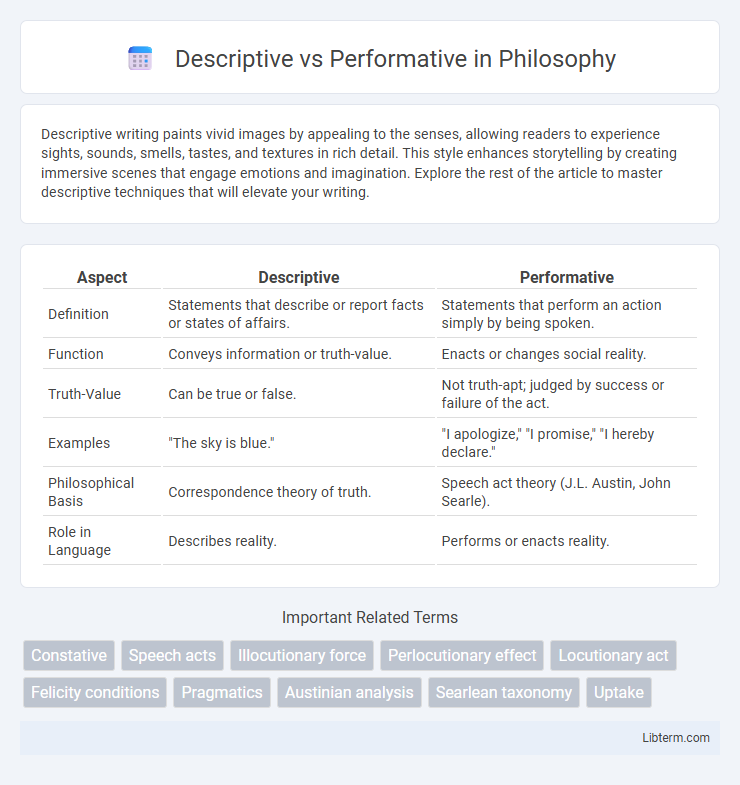Descriptive writing paints vivid images by appealing to the senses, allowing readers to experience sights, sounds, smells, tastes, and textures in rich detail. This style enhances storytelling by creating immersive scenes that engage emotions and imagination. Explore the rest of the article to master descriptive techniques that will elevate your writing.
Table of Comparison
| Aspect | Descriptive | Performative |
|---|---|---|
| Definition | Statements that describe or report facts or states of affairs. | Statements that perform an action simply by being spoken. |
| Function | Conveys information or truth-value. | Enacts or changes social reality. |
| Truth-Value | Can be true or false. | Not truth-apt; judged by success or failure of the act. |
| Examples | "The sky is blue." | "I apologize," "I promise," "I hereby declare." |
| Philosophical Basis | Correspondence theory of truth. | Speech act theory (J.L. Austin, John Searle). |
| Role in Language | Describes reality. | Performs or enacts reality. |
Introduction to Descriptive and Performative
Descriptive language provides objective information by depicting facts, events, or characteristics, establishing a clear representation of reality. Performative language, in contrast, functions as a form of action where uttering certain phrases directly enacts or initiates an activity, such as making promises or issuing commands. Understanding the distinction between descriptive and performative expressions is essential in fields like linguistics, philosophy of language, and communication studies.
Defining Descriptive Statements
Descriptive statements convey factual information by depicting reality or states of affairs, providing objective content that can be evaluated as true or false. They function to describe events, objects, or conditions without altering the situation they refer to, serving as linguistic representations of existing facts. In contrast, performative statements enact an action through utterance, such as promises or declarations, thereby changing the social reality rather than merely reporting it.
Understanding Performative Utterances
Performative utterances are speech acts that accomplish an action simply by being spoken, such as making promises or issuing orders, rather than merely describing a state of affairs. Understanding performative utterances requires recognizing their role in context, where the speaker's intent and the social conventions activate the performative function. Unlike descriptive statements that convey information, performative utterances inherently change reality by the act of articulation.
Key Differences Between Descriptive and Performative
Descriptive sentences report facts or state conditions, providing information about the world without causing any change, such as "The sky is blue." Performative sentences perform an action through the act of stating them, like "I apologize" or "I promise," where speaking the sentence enacts the event. The key difference lies in function: descriptive language conveys information passively, while performative language actively changes social reality through speech acts.
Historical Perspectives on Speech Acts
Historical perspectives on speech acts trace back to J.L. Austin's seminal work distinguishing descriptive utterances, which describe reality, from performative utterances that enact an action through speaking. Austin's "How to Do Things with Words" (1962) introduced the foundational concept that certain statements do not merely convey information but perform acts, such as promising or apologizing. Subsequent developments by John Searle refined this theory, categorizing illocutionary acts and emphasizing the context-dependent nature of performatives within linguistic philosophy.
Real-World Examples of Descriptive Language
Descriptive language captures observable facts and characteristics, such as "The sky is blue" or "The car is parked outside," providing clear, verifiable information about real-world conditions. In scientific reports, descriptive statements like "The temperature is 22 degrees Celsius" serve to document measurable phenomena without invoking action or change. Advertisements often use descriptive language to detail product features, for example, "This laptop has 16GB RAM and a 512GB SSD," emphasizing concrete attributes that inform consumer decisions.
Real-World Examples of Performative Language
Performative language actively changes reality by performing an action through speech, such as when a judge declares "I hereby sentence you," thereby enacting a legal consequence. Wedding vows exemplify performative utterances, where saying "I do" legally binds individuals in marriage. Another real-world example is a politician's oath of office, which formally confers authority and responsibility upon taking the pledge.
Impact on Communication and Meaning
Descriptive statements convey information that reflects reality and can be evaluated for truthfulness, significantly impacting clarity and understanding in communication by establishing facts. Performative statements, by contrast, enact an action simply through their utterance, shaping meaning dynamically and influencing social interactions and relationships. The distinction affects how messages are interpreted, with descriptive language grounding communication in objective reality while performative language actively shapes social context and meaning.
Applications in Linguistics and Philosophy
Descriptive language functions to depict or characterize reality, providing information about states, events, or qualities without altering them, which is crucial in linguistic analysis for understanding how meaning is conveyed in everyday communication. Performative language, as identified by philosopher J.L. Austin, executes an action simply by being spoken, such as in utterances like "I apologize" or "I promise," which are essential for studying speech acts and understanding the pragmatic effects of language in social contexts. Applications in linguistics and philosophy examine how these distinctions influence syntax, semantics, and pragmatics, shaping theories of meaning, language use, and the performative power of speech in shaping social reality.
Conclusion: Choosing Between Descriptive and Performative
Choosing between descriptive and performative approaches depends on the context and desired impact; descriptive language effectively conveys objective information and clarity, while performative language influences actions and shapes social realities. In decision-making, combining both methods enhances communication by providing factual details and motivating behavior. Prioritizing context ensures the appropriate balance, maximizing effectiveness in conveying meaning and prompting response.
Descriptive Infographic

 libterm.com
libterm.com